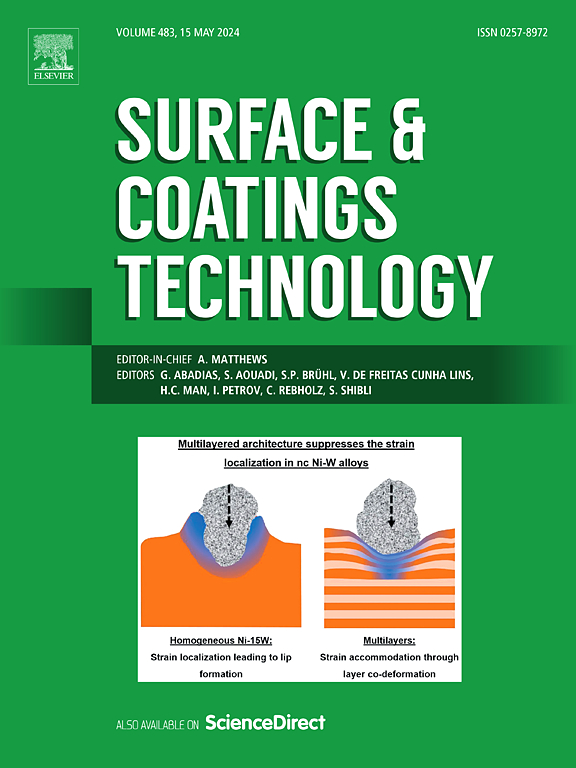On the relationship between particle melting degree and phase transformation of alumina and alumina-based solid solution powders during atmospheric plasma spraying
IF 5.3
2区 材料科学
Q1 MATERIALS SCIENCE, COATINGS & FILMS
引用次数: 0
Abstract
The polymorphism and the thermo-physical properties of alumina create significant challenges for deposition of thermally sprayed coatings. For a better understanding of the associated phenomena, in this study two feedstock powders (one commercial plain alumina powder and one experimental solid solution powder (initial composition 83.0 mol% Al2O3, 8.5 mol% Cr2O3 and 8.5 mol% TiO2) both consisting mainly of the corundum phase were deposited by atmospheric plasma spraying (APS) using three different spray parameter sets. For each parameter set, the plasma jet area was studied as well as the fluctuation using a high-speed camera. Particle temperature and velocity were measured using a particle diagnostic tool. In addition, powders were collected in flight to study the melting state of the particles to improve the understanding of the phase transformation. The results show that the particle melting state is closely related to the particle temperature and is significantly influenced by the electrical power and the particle velocity. The experimental Al2O3-based solid solution powder shows significantly improved melting behavior. Controlling the melting state of the particles in order to achieve a high amount of α-phase is more difficult for the plain Al2O3 powder than for the alumina-based solid solution powder. Under the conditions studied, for plain Al2O3, a deterioration of the particle melting state leads to a reduction in deposition efficiency without effect on the phase composition in the coating, while for the alumina-based solid solution, the phase composition can be influenced in favor of a higher α-phase content without affecting the deposition efficiency.
大气等离子喷涂过程中氧化铝及铝基固溶体粉末颗粒熔化度与相变的关系
氧化铝的多晶态和热物理性质为热喷涂涂层的沉积带来了重大挑战。为了更好地理解相关现象,本研究采用三种不同的喷涂参数,采用大气等离子喷涂(APS)沉积了两种主要由刚玉相组成的原料粉末(一种是商业普通氧化铝粉末,一种是实验固溶体粉末(初始成分为83.0 mol% Al2O3, 8.5 mol% Cr2O3和8.5 mol% TiO2)。利用高速摄像机对每组参数的等离子体射流面积及其波动进行了研究。使用粒子诊断工具测量粒子温度和速度。此外,在飞行中收集粉末,研究颗粒的熔化状态,以提高对相变的认识。结果表明:颗粒熔化状态与颗粒温度密切相关,且受电功率和颗粒速度的显著影响;实验al2o3基固溶体粉末的熔化性能明显改善。普通Al2O3粉末比氧化铝基固溶体粉末更难控制颗粒的熔化状态以获得高含量的α-相。在所研究的条件下,对于普通Al2O3,颗粒熔融状态的恶化会导致沉积效率降低,但不会影响涂层中的相组成,而对于氧化铝基固溶体,可以影响相组成,有利于提高α-相含量,但不会影响沉积效率。
本文章由计算机程序翻译,如有差异,请以英文原文为准。
求助全文
约1分钟内获得全文
求助全文
来源期刊

Surface & Coatings Technology
工程技术-材料科学:膜
CiteScore
10.00
自引率
11.10%
发文量
921
审稿时长
19 days
期刊介绍:
Surface and Coatings Technology is an international archival journal publishing scientific papers on significant developments in surface and interface engineering to modify and improve the surface properties of materials for protection in demanding contact conditions or aggressive environments, or for enhanced functional performance. Contributions range from original scientific articles concerned with fundamental and applied aspects of research or direct applications of metallic, inorganic, organic and composite coatings, to invited reviews of current technology in specific areas. Papers submitted to this journal are expected to be in line with the following aspects in processes, and properties/performance:
A. Processes: Physical and chemical vapour deposition techniques, thermal and plasma spraying, surface modification by directed energy techniques such as ion, electron and laser beams, thermo-chemical treatment, wet chemical and electrochemical processes such as plating, sol-gel coating, anodization, plasma electrolytic oxidation, etc., but excluding painting.
B. Properties/performance: friction performance, wear resistance (e.g., abrasion, erosion, fretting, etc), corrosion and oxidation resistance, thermal protection, diffusion resistance, hydrophilicity/hydrophobicity, and properties relevant to smart materials behaviour and enhanced multifunctional performance for environmental, energy and medical applications, but excluding device aspects.
 求助内容:
求助内容: 应助结果提醒方式:
应助结果提醒方式:


